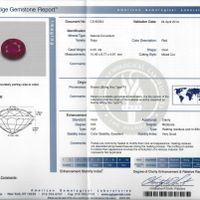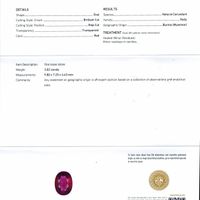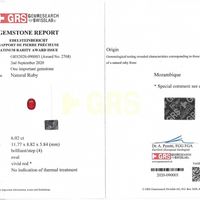Ruby Certification Importance Explained
Purchasing a ruby is a significant investment, and ensuring its authenticity, quality, and value requires a certification from a reputable gemological laboratory. Ruby Certification Importance Explained helps buyers understand why a certified ruby provides verified details about origin, treatments, and quality factors. Ruby Certification Importance Explained also highlights how proper certification protects buyers from synthetic or misrepresented stones and guides them in choosing a trustworthy gemological lab.

1. What is a Ruby Certification?
A ruby certification is an official gemological report issued by a laboratory that examines and grades the gemstone based on its color, clarity, cut, carat weight, origin, and treatments.
✔ Confirms if the ruby is natural or synthetic.
✔ Identifies any treatments or enhancements applied.
✔ Provides origin details, affecting rarity and value.
✔ Helps buyers determine authenticity and fair pricing.



2. Why is Ruby Certification Important?
A. Ensures Authenticity & Protects Against Fakes
The market is flooded with synthetic rubies, glass-filled stones, and imitation gems. A certification from a trusted lab confirms that the ruby is natural and not an artificial substitute.
✅ Certified Ruby: Verified as natural, ensuring genuine value.
❌ Uncertified Ruby: Could be a synthetic or a treated stone misrepresented as high-quality.
B. Confirms Treatments & Enhancements
Many rubies undergo heat treatment or fracture filling to improve their appearance. Certification reveals:
✔ Untreated Rubies: More valuable due to their natural state.
✔ Heat-Treated Rubies: Common and accepted but lower in value than untreated stones.
✔ Lead-Glass Filled Rubies: Less durable and significantly cheaper.
Without certification, sellers may misrepresent a heavily treated ruby as high-quality.
C. Determines Ruby Origin & Value
A ruby’s geological source affects its desirability and market price.
- Burmese (Myanmar) Rubies: Most sought-after, especially Pigeon Blood Red varieties.
- Mozambique Rubies: Highly valued with rich color and clarity.
- Thai Rubies: Often darker with a purplish tone.
✅Certified reports specify origin, helping buyers understand rarity and pricing.
D. Assists in Fair Pricing & Investment Decisions
A certified ruby comes with a detailed assessment of quality factors, allowing buyers to compare stones objectively.
✔ Prevents overpaying for misrepresented rubies.
✔ Ensures transparency in buying and reselling rubies.
E. Essential for Resale & Insurance Purposes
- Insurance companies require certification to establish the ruby’s value.
- Certified rubies fetch higher resale prices and are easier to sell.
3. What Information is Included in a Ruby Certification?
| Certificate Detail | Description | Why It Matters |
| Gem Type | Identifies if the stone is a natural ruby or synthetic | Confirms authenticity |
| Weight (Carat) | Lists the carat weight of the ruby | Determines price per carat |
| Color | Describes the hue, tone, and saturation | Affects value (Pigeon Blood Red is most valuable) |
| Clarity | Details visible inclusions or imperfections | Impacts transparency and quality |
| Cut & Shape | Identifies the cut style (oval, cushion, round, etc.) | Determines brilliance and symmetry |
| Treatments | States if the ruby has been heated, fracture-filled, or untreated | Affects durability and value |
| Origin | Determines where the ruby was mined | Burmese and Mozambique rubies are more valuable |
| Fluorescence | Indicates how the ruby reacts to UV light | Helps confirm authenticity |
| Certification Number | Unique ID for verification | Allows traceability |
R14700| play | medium| middle| “1.02 Ct. Ruby from Madagascar”
4. Best Gemological Laboratories for Ruby Certification
Not all gem labs are reliable. The most trusted certification institutes include:
✔ GIA (Gemological Institute of America) – Highly respected, unbiased grading.
✔ GRS (GemResearch Swisslab) – Specializes in colored gemstones, well-known for origin verification.
✔ AGL (American Gemological Laboratories) – Recognized for advanced treatment detection.
✔ SSEF (Swiss Gemological Institute) – Trusted for premium gemstones, especially rubies.
✔ Lotus Gemology – Expertise in ruby, sapphire, and spinel certification.
Avoid uncertified or unknown labs, as they may provide misleading reports or lack credibility.
5. How to Verify a Ruby Certification
To ensure a ruby certificate is legitimate:
✔ Check the lab’s website for verification using the certificate number.
✔ Look for security features (holograms, seals, barcodes).
✔ Compare grading terms (reputable labs use consistent color and clarity descriptions).
✔ Ask the seller for a digital copy before purchasing.

6. Should You Buy an Uncertified Ruby?
❌ Risks of buying an uncertified ruby:
- It may be synthetic or glass-filled.
- The treatment details may be hidden, affecting durability.
- Difficult to resell or insure.
✅ Certified rubies provide peace of mind, ensuring you’re investing in a genuine, high-quality gemstone.
7. Conclusion
Ruby Certification Importance Explained highlights why certification is essential for verifying a gemstone’s authenticity, treatments, origin, and value. A certified ruby ensures transparency, fair pricing, and long-term investment security. Ruby Certification Importance Explained also emphasizes the need to insist on a reliable gemological certificate from a trusted lab before purchasing, especially for high-value stones.
To learn more about the unique features of natural rubies, we invite you to visit our comprehensive Identifying Natural Ruby Characteristics guide.
